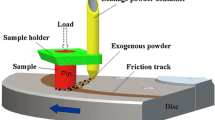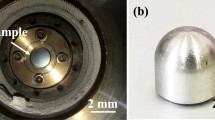Abstract
To improve the solid lubricity on the worn surface of frictional-pairs, a convenient and simple brush-painting technique was utilized to prepare the solid lubrication graphite coatings. The bonding between the coatings and substrate is good. To examine the influence of the different graphite contents on the tribological properties of the graphite coatings, the comparison experiments were carried out on the ring-on-block friction tester. The tribological results show a change law of saddle-shape between the tribological properties of graphite coatings and graphite content. When the amount of graphite is up to 28 g, the tribological properties of graphite coating are the best. The excellent anti-friction of the graphite coating is associated with the close-packed hexagonal crystal structure of graphite.
Similar content being viewed by others
References
Wang H D, Zhuang D M, Wang K L, et al. Comparative investigation on tribological properties of ion sulfuration layers under dry friction[J]. Tribology Letters, 2002, 13(7): 55–61.
Wang H D, Zhuang D M, Wang K L, et al. Comparison of the tribological properties of an ion sulfurized coating and a plasma sprayed FeS coating[J]. Materials Science and Engineering A, 2003, 57(1–2): 321–327.
Matsui T, Yudasaka M, Kikuchi R, et al. Structure of nitrogen-substituted graphite films prepared by chemical vapor deposition[J]. Materials Science and Engineering B, 1995, 29(1–3): 220–222.
Wang H D, Xu B S, Liu J J, et al. Microstructures and friction-reduction performances of the graphite coatings[J]. Materials Letters, 2005, 59(13): 1683–1686.
Moustafa S F, El-Badry S A, Sanad A M, et al. Friction and wear of copper-graphite composites made with Cu-coated and uncoated graphite powders[J]. Wear, 2002, 253(7–8): 699–710.
Kang F Y, Zheng Y P, Wang H N, et al. Effect of preparation conditions on the characteristics of exfoliated graphite[J]. Carbon, 2002, 40(9): 1575–1581.
Almaral J L, Alvarez J, Araujo C, et al. Preparation and characterization of sol-gel silica based neutral optical density coatings by the addition of graphite particles[J]. Thin Solid Films, 2003, 423(2): 196–200.
Cui Y, Cui Y, Ma Z M. A Kind of Anti-corrosion Paint[P]. China: 99103350. 1999. (in Chinese)
Hussain A A A, Al-Bassam T S. Effects of deposition parameters on the structure of thin gadolinium films [J]. Thin Solid Films, 1979, 59(1): 77–89.
Stacchiola D, Kaltchev M, Wu G, et al. The adsorption and structure of carbon monoxide on ethylidyne-covered Pd(111)[J]. Surface Science, 2000, 470(1–2): L32-L38.
Antolini E, Cardellini F. Formation of carbon supported PtRu alloys: an XRD analysis[J]. Journal of Alloys and Compounds, 2001, 315(1–2): 118–122.
Chen R, Li P, Lu Y J. Solid lubrication material-graphite[J]. Carbon, 2000(4): 23–6. (in Chinese)
Author information
Authors and Affiliations
Corresponding author
Rights and permissions
About this article
Cite this article
Zhu, Yl. Comparison of tribological properties for graphite coatings used for remanufacturing. J Cent. South Univ. Technol. 12, 41–44 (2005). https://doi.org/10.1007/s11771-005-0008-y
Received:
Accepted:
Issue Date:
DOI: https://doi.org/10.1007/s11771-005-0008-y




